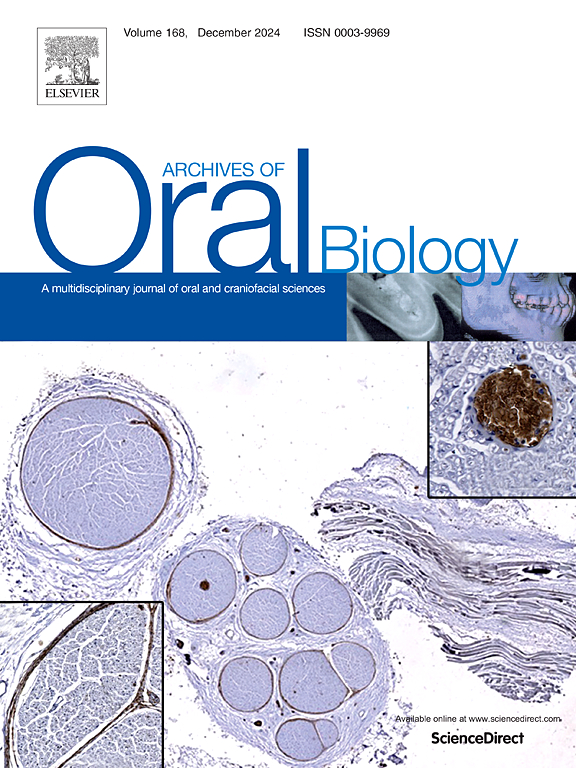帕瑞昔布和地塞米松对去睾丸大鼠颞下颌关节的影响:形态学和免疫学分析
IF 2.1
4区 医学
Q2 DENTISTRY, ORAL SURGERY & MEDICINE
引用次数: 0
摘要
目的通过组织学和免疫学分析,评价帕雷昔布(一种选择性COX-2抑制剂)和地塞米松(一种皮质类固醇)对睾丸激素缺乏模型大鼠去睾丸后颞下颌关节(TMJ)的影响。方法36只大鼠随机分为6组(n = 6)。假手术组给予生理盐水、帕瑞昔布(0.3 mg/kg)或地塞米松(0.1 mg/kg)。ORX组接受相同的治疗。对TMJs进行组织学染色(甲苯胺蓝和小sirius红),并进行组织形态学分析,测量软骨总厚度及其层数(纤维状、增生、成熟、肥厚)。ELISA法检测细胞因子(IL-1α、IL-1β、IL-6、TNF-α)。数据分析采用ANOVA-Welch和Kruskal-Wallis检验。结果sorx升高IL-1α、IL-1β、TNF-α水平。地塞米松降低IL-6。地塞米松还能降低软骨厚度,加速软骨向软骨下骨的分化。相反,帕瑞昔布保留了软骨的厚度,尤其是纤维层和增生层,并增加了蛋白多糖的含量。两种药物都能降低炎症标志物,但具有明显的结构效应。结论睾酮缺乏可加重颞下颌关节炎症,损害软骨结构。虽然地塞米松和帕瑞昔布都调节了这些作用,但它们的作用不同:地塞米松促进了软骨向骨的分化,长期来看可能不利,而帕瑞昔布保持了软骨的完整性。这些发现强调了激素的影响,并支持在雄激素缺乏的情况下选择抗炎策略来保护TMJ。本文章由计算机程序翻译,如有差异,请以英文原文为准。
Effect of parecoxib and dexamethasone on the temporomandibular joint of orchiectomized rats: Morphological and immunological analysis
Objective
To evaluate the effects of parecoxib (a selective COX-2 inhibitor) and dexamethasone (a corticosteroid) on the temporomandibular joint (TMJ) of orchiectomized rats, a model of testosterone deficiency, through histological and immunological analyses.
Methods
Thirty-six rats were divided into six groups (n = 6). Sham groups received saline, parecoxib (0.3 mg/kg), or dexamethasone (0.1 mg/kg). ORX groups received the same treatments. TMJs were processed for histological staining (toluidine blue and picrosirius red) and analyzed by histomorphometry, measuring total cartilage thickness and its layers (fibrous, proliferative, mature, hypertrophic). Cytokines (IL-1α, IL-1β, IL-6, TNF-α) were quantified by ELISA. Data were analyzed using ANOVA-Welch and Kruskal-Wallis tests.
Results
ORX increased IL-1α, IL-1β, and TNF-α levels. IL-6 was reduced by dexamethasone. Dexamethasone also decreased cartilage thickness and accelerated its differentiation into subchondral bone. In contrast, parecoxib preserved cartilage thickness, especially in the fibrous and proliferative layers, and increased proteoglycan content. Both drugs reduced inflammatory markers, but with distinct structural effects.
Conclusions
Testosterone deficiency enhanced TMJ inflammation and impaired cartilage structure. While both dexamethasone and parecoxib modulated these effects, their actions differed: dexamethasone promoted cartilage-to-bone differentiation, potentially unfavorable long term, whereas parecoxib preserved cartilage integrity. These findings underscore hormonal influence and support selective anti-inflammatory strategies for TMJ preservation under androgen deficiency.
求助全文
通过发布文献求助,成功后即可免费获取论文全文。
去求助
来源期刊

Archives of oral biology
医学-牙科与口腔外科
CiteScore
5.10
自引率
3.30%
发文量
177
审稿时长
26 days
期刊介绍:
Archives of Oral Biology is an international journal which aims to publish papers of the highest scientific quality in the oral and craniofacial sciences. The journal is particularly interested in research which advances knowledge in the mechanisms of craniofacial development and disease, including:
Cell and molecular biology
Molecular genetics
Immunology
Pathogenesis
Cellular microbiology
Embryology
Syndromology
Forensic dentistry
 求助内容:
求助内容: 应助结果提醒方式:
应助结果提醒方式:


